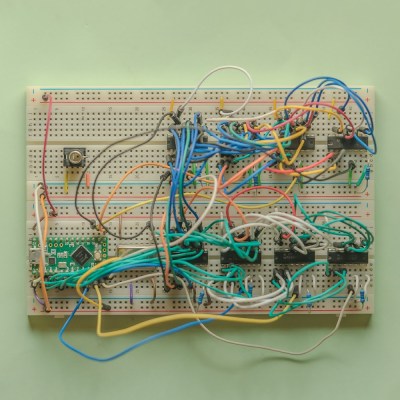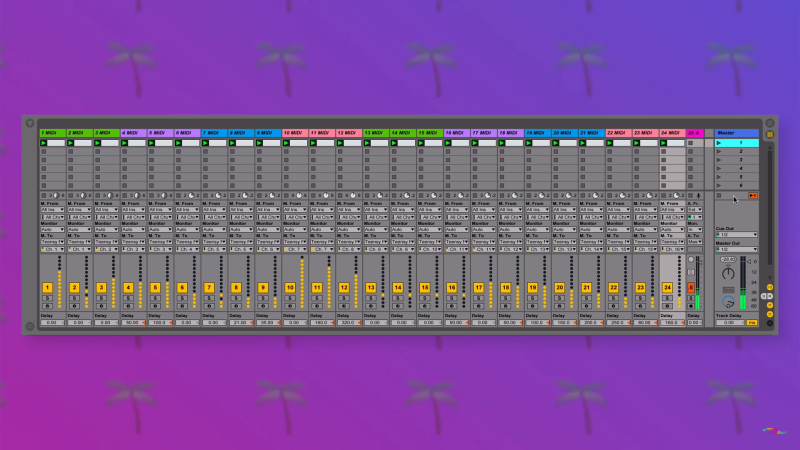Way back in the dark ages, before the average computer could play back high quality recorded audio, things were done differently. Music and sounds were stored as instructions to be played back on audio synthesis chips, built into the computers and consoles of the 80s and 90s. These chips and their unique voices hold a special nostalgia that’s key to this era, making them popular to experiment with today. To that end, [little-scale] decided to wire up eight chips from the SEGA Master System to please your ears.

The chip in question is the SN76489, which we’ve also noted is used in the Sega Genesis as well. It packs 3 square wave tone generators, and a noise channel as well. With eight of these to play with, that’s 32 total channels. To drive these, [little-scale] decided to go the MIDI route. To get around the MIDI limit of 16 channels, he decided to split the frequency range in half. Each MIDI channel addresses two SN76489 channels, the top pitches being used for one, the lower pitches being used for the other. All this MIDI data is passed to a Teensy LC, which handles transposition of the note data to get everything back in tune, and addresses the eight chips to create a beautiful square wave symphony.
It’s a great way to create a cacophony of sound in a delightful vintage way, and code is available if you’d like to recreate the feat. What we’d like to know is this – what’s your favourite sound chip from yesteryear, and how badly do you want eight of them to sing in glorious harmony?
















The best classic sound chip IMO has to be the legendary MOS Technologies 6581 SID chip. The SID was far superior to most other sound chips of the day like the Texas Instruments SN76849 (used in the Master System, TI99 and BBC Micro among others), the General Instrument AY-3-8910 (used in the later ZX Spectrum variants and some of the Apple II sound cards for example), the beeps from the IBM PC speaker and whatever proprietary thing the NES had in there.
It wasn’t until the first cards with the Yamaha FM synthesis chips like the AdLib came out that audio on computer systems got better than the SID IMO.
But in practice SID was inferior to much older Pokey ;)
The under represented “volume only output” for the win! :-)
wow, those chips are really, really cheap on the Bay.
I thought you missed a sarcasm tag. But a quick look shows £3 for 10 units
Quote:
“Way back in the dark ages, before the average computer could play back high quality recorded audio, things were done differently.”
The Sega Master System was released around the same time as the Commodore Amiga A500 (So before I was born).
The A500 had (By today’s standards) a 4-slot (“4 channels” AKA Paula) user-supplied wave table commonly tied to LEFT, RIGHT, RIGHT, LEFT. and was ONE* of the earliest 8-bit** PCM systems available for the consumer market.
So you’ll have to look as far back as the Commodore 64 to find the time when the only audio was synth chips.
To be honest, the Commodore Amiga ranges were very far ahead of their time.
P.s. I’ve got a decent collection of .mod tunes (Octo-Med and similar compatible modules).
* There probably was earlier systems, yet not of what I’d known of…
** OK not exactly “High quality”, yet fairly high quality for the time given the alternatives.
MOD music is kind of underrepresented these days with the abundance of MP3. But one could still get some good music out of them.
Ah, the good old days.
MOD, S3M, XM.
The main reasons for using synths back in those days were, in no particular order:
– storing waveforms takes a lot of storage. In those days, a lot of us were using cassettes, the lucky ones were using floppy discs of less than half a megabyte.
– the computers had 64KB RAM at best.
– the CPU speed was under 5MHz
It’s easy to see why you had to use synthesizers with all these limitations. Some games used tricks to play very short samples compressed 4:1 with ADPCM, but even still, an 8KHz audio sample took 2KB per second.
Did I mention there was only the main RAM? No GPU and no dedicated RAM for graphics like today, so you had to store the program, the graphics, the music and the samples all in that tiny 64KB.
Back then, bloatware did not exists because you either knew how to code or you didn’t code.
I believe there are people who still make MOD music, but those good old days were when you could get a full library for the price of a disc, and MODS can still sound good.
Take a look at H0ffman on ModArchive [Link], The ones like Krunk’d, Pattern Skank and The Hunter all have some good samples…
Then I’d advise looking on Youtube for the “best of (insert genre name) on amiga compilation”.
You’ll land up eating up a little over 1GB and yet have thousands of tunes from searching these .MOD. (In MP3 format they’ll take an estimate of over 3.5GB)
Grab a copy of Schismtracker (Or apt-get/pacman -i schism if you want the distro specific copy). Learn how to open+play the MODs… F3 for sample lists and repeat breakbeat samples so you can feel like a “1-button DJ”. :-D
LOL @ “Good old days”
My first music was done on a TRS-80 using machine code generated PWM on the tape out to the cassette player.
I also made many interesting sounds for games.
EC8OR used an Amiga well up thru the 2000s to drive gear with no problems. I think Patric C still uses it for his tracker.
“before the AVERAGE computer” “high quality recorded audio”
Proud A500 owner here, y’don’t have to tell me hahaha
The Amiga sure wasn’t average computer. It has never been and likely will never been. Yet, it wasn’t quite playing back HiFi recorded audio. Afaik, it was limited to 8KHz or 16KHz 8-bit samples (opposed to 16-bit 44kHz of CD quality) and it made music by playing the same samples on various pitches. That means it could only fake ‘playing back recorded audio’ for adequately composed tracks.
Nice to see little-scale is still doing little-scale type stuff ;). Always liked their ambient and extremely experimental style.
Me too!
(OT) How about using the noise channel for a hardware Random number generator?(/OT)
It’s an LFSR, wholly inappropriate for RNG purposes.
Ah. Another dream nipped in the bud.
On to greener pastures, then, like Voja Antonics uninitialised RAM…
But can it play Deep Note?
https://youtu.be/uYMpMcmpfkI
The irony of a YouTube video with the title “original uncompressed audio” does not escape me.
I see your off-topic comment and raise you one interesting Hackaday link: Deep Note in Supercollider
Oh sweet.
btw I got to meet and talk with Dr. James A. Moorer in the mid 90s when I worked for the Canadian rep of the product he was involved with at that time (Sonic Solutions).
/derail